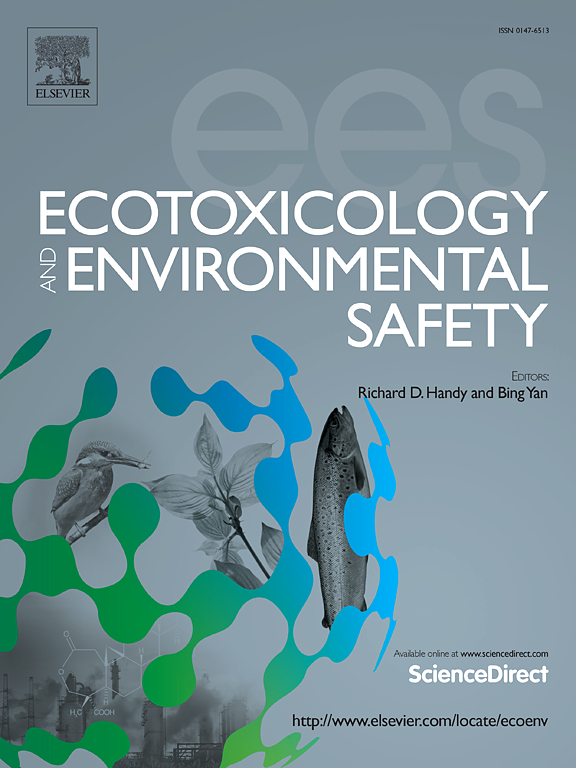百草枯诱导的帕金森病样神经变性自噬损伤中小胶质细胞异质性的表征
IF 6.2
2区 环境科学与生态学
Q1 ENVIRONMENTAL SCIENCES
引用次数: 0
摘要
帕金森病(PD)是一种常见的神经退行性疾病,受环境因素的影响,特别是百草枯(PQ)是已知的危险因素之一。自噬受损是PD发病的关键因素,但PD中与自噬相关的细胞异质性研究尚未深入。在此,我们建立了PQ诱导的PD样神经变性模型,发现PQ在实验性PD进展过程中损害了自噬。利用单细胞RNA测序(scRNA-seq),我们在该模型中阐明了自噬相关的转录组景观,确定了小胶质细胞是与pq诱导的自噬相关的所有脑细胞类型的中心细胞类型。此外,pq暴露模型中的小胶质细胞亚型在基因表达特征、生物学功能和自噬调节中的作用方面表现出显著的异质性。PQ暴露诱导了小胶质细胞亚型之间潜在的遗传转化,这可能进一步破坏它们的免疫反应和能量代谢调节功能。随后,我们在体内和体外PQ暴露模型中验证了scRNA-seq揭示的小胶质细胞身份转化。此外,我们确定了一种特定的小胶质细胞亚型,主要负责在pq暴露模型中观察到的自噬相关变化。自噬亚型标记基因Inpp5d的表达可能参与了pq诱导的BV2细胞自噬损伤的调控。本研究生成了PQ暴露背景下自噬的第一个scRNA-seq图谱,强调了小胶质细胞亚型的异质性,并确定了自噬特异性小胶质细胞亚型在PQ诱导的pd样神经变性病理中的中心机制。本文章由计算机程序翻译,如有差异,请以英文原文为准。
Characterizing microglial heterogeneity in autophagy impairment of Paraquat-induced Parkinson’s disease-like neurodegeneration
Parkinson's disease (PD) is a prevalent neurodegenerative condition influenced by environmental elements, notably Paraquat (PQ), which is one of the known risk factors. Impaired autophagy is a critical factor in the pathogenesis of PD, yet the cellular heterogeneity related to autophagy in PD has not been thoroughly investigated. Here, we established a PQ-induced PD-like neurodegeneration model and found that PQ impairs autophagy during experimental PD progression. Using single-cell RNA sequencing (scRNA-seq), we elucidated the autophagy-related transcriptomic landscapes in this model, identifying microglia as the central cell type associated with PQ-induced autophagy across all brain cell types. Additionally, microglial subtypes in the PQ-exposed model exhibited significant heterogeneity in gene expression characteristics, biological functions, and roles in autophagic regulation. PQ exposure induced potential genetic transformations between microglial subtypes, which may further disrupt their immune response and energy metabolism regulation functions. Subsequently, we validated the identity transformation of microglia revealed by scRNA-seq in both in vivo and in vitro PQ exposure models. Moreover, we identified a specific microglial subtype primarily responsible for the autophagy-related changes observed in the PQ-exposed model. The expression of the autophagic subtype marker gene Inpp5d may contribute to the regulation of PQ-induced autophagic impairment in BV2 cells. This study generates the first scRNA-seq atlas of autophagy in the context of PQ exposure, highlighting the heterogeneity of microglial subtypes and identifying an autophagy-specific microglial subtype as a central mechanism in the pathology of PQ-induced PD-like neurodegeneration.
求助全文
通过发布文献求助,成功后即可免费获取论文全文。
去求助
来源期刊
CiteScore
12.10
自引率
5.90%
发文量
1234
审稿时长
88 days
期刊介绍:
Ecotoxicology and Environmental Safety is a multi-disciplinary journal that focuses on understanding the exposure and effects of environmental contamination on organisms including human health. The scope of the journal covers three main themes. The topics within these themes, indicated below, include (but are not limited to) the following: Ecotoxicology、Environmental Chemistry、Environmental Safety etc.

 求助内容:
求助内容: 应助结果提醒方式:
应助结果提醒方式:


